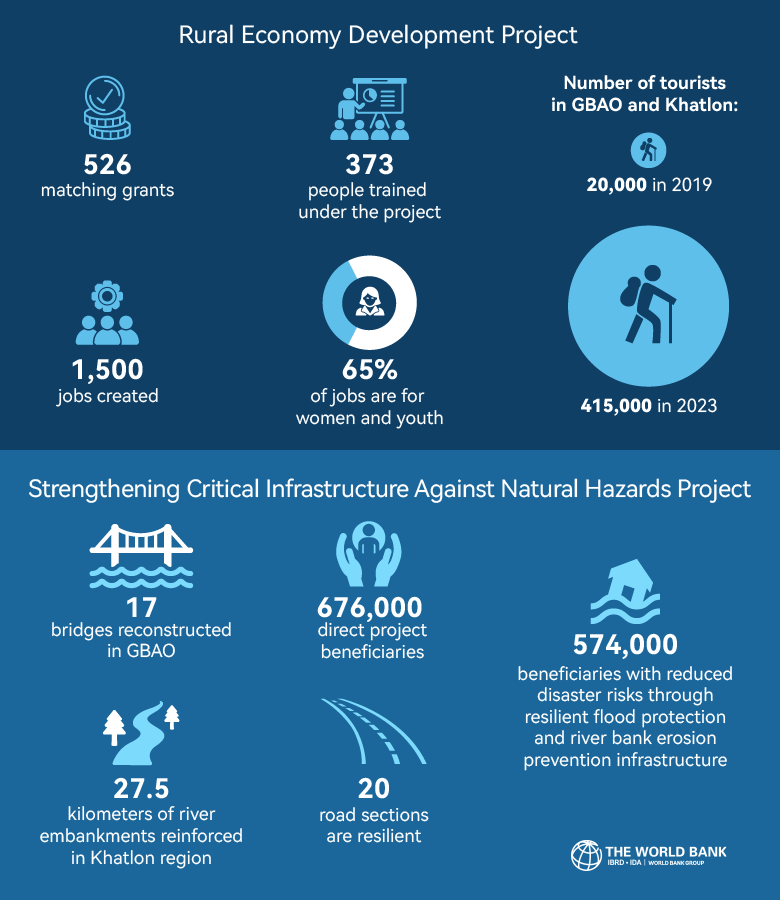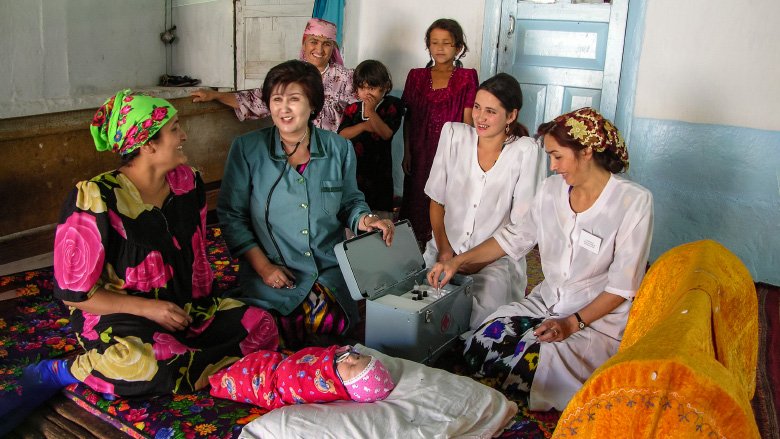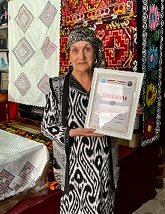Key Highlights
- More than 13,000 smallholder farmers received high quality seeds and fertilizers under the Strengthening Resilience of Agriculture Sector Project (SRASP), which is helping boost the productivity of the key crops such as wheat, cotton, potato, and vegetables.
- The Tajikistan Rural Economy Development Project (REDP) created 1,500 jobs and allocated 526 matching grants to farmers, entrepreneurs and micro, small, and medium enterprises (MSMEs) in the tourism, agribusiness, and other related sectors in the Gorno-Badakhshan Autonomous Oblast (GBAO) and Khatlon region.
- The Health Services Improvement Project (HSIP) contributed to improved coverage and quality of basic primary health care services in rural health facilities in 16 districts and immunization of more than 100,000 children between 2015 and 2023.
- The Strengthening Critical Infrastructure against Natural Hazards Project (SCINHP) has rehabilitated 17 bridges in GBAO, reinforced 27.5 kilometers of river embankments in Khatlon region, renovated 20 critical road sections—efforts benefiting 676,000 people.
Beneficiary
Challenge
Tajikistan faces ongoing social vulnerabilities and fragility risks because of factors including: the legacy of its 1992–1997 civil war, pockets of poverty in less developed and rural areas, income insecurity, high levels of under‐ and unemployment, and security risks from its 1,400‐kilometer border with Afghanistan. More than one in three youth and almost nine out of 10 young women are unemployed or not enrolled in education or training. And there are groups of people across the country such as returning and deported migrants and abandoned wives, who are often excluded from their communities. Moreover, environmental vulnerabilities to disasters, land degradation, and unsustainable use of natural resources pose constraints for rural development.
A series of socio-economic challenges since the adoption of the Country Partnership Framework (CPF) for FY19-24 have exacerbated the country’s poverty and inequality, including the COVID-19 pandemic, the fall of the government in Afghanistan and subsequent influx of refugees, Russia’s invasion of Ukraine, and disasters including floods, mudslides, and earthquakes. Food safety represents one of the most pressing issues for Tajikistan’s agricultural sector, in which has not conformed with International Sanitary and Phytosanitary Standards. There is a critical need for market laboratories to improve their facilities and upgrade water supply channels, air conditioners, computers, and laboratory equipment. Several market laboratories were using outdated microscopes, insufficient to test animal products such as meat, milk, eggs, honey, and fish.
Approach
The World Bank Group CPF for FY19-24 with Tajikistan places a strong emphasis on a preventative approach to addressing the country’s identified risks. The CPF has prioritized an objective of “Improving the Resilience of Residents in Local Communities” under the Human Capital and Resilience focus area, concentrating on the International Development Association (IDA) RMR‐funded Resilience Strengthening Program in the Gorno-Badakshan Autonomous Oblast (GBAO) and the Khatlon region, which are particularly vulnerable to natural hazards and fragility, conflict, and violence (FCV). World Bank Group interventions have also sought to address challenges emanating from a deteriorating ecological environment. Taken together, these interventions aiming to enhance Tajikistan’s resilience to crises were multisectoral in nature, including operations in health, agriculture, tourism, social development, and disaster risk management. These projects focused on increasing social cohesion and strengthening local institutions; developing youth inclusive services and livelihood support; improving basic health infrastructure; creating new economic opportunities in community-based tourism; investing in disaster risk management; and elevating food safety.
As a whole, the World Bank’s approach has also incorporated an innovative aspect: deploying instruments to prevent or address FCV, implemented as part of the IDA Risk Mitigation Regime, as well as regular operations, with different modes of support working in tandem to build Tajikistan’s resilience to crises and instability. These instruments include the Inclusion and Resilience Lens, Crisis Preparedness Gap Analysis and the Catastrophe Deferred Drawdown Option (which allows countries to quickly access emergency funds in the event of a qualifying disaster). Projects provided support for the Government of Tajikistan to develop resilience-enhancing strategies.
Results
Since the adoption of the CPF in 2019, significant progress has been achieved in enhancing the resilience of the population in the areas of enhanced basic health services, improved infrastructure for vulnerable communities, growth in the agricultural and tourism initiatives, and better disaster preparedness. Overall, from 2014 to 2023, almost three million people benefitted directly from five resilience building projects in Tajikistan:
- Since 2014, the Health Services Improvement Project (HSIP) has worked to increase the coverage and quality of basic primary healthcare services in Tajikistan covering two million people. With HSIP’s support, by 2023, 37 new rural health centers had been built and equipped, 481 primary healthcare facilities were provided with medical and IT equipment, and 13,867 healthcare staff received training, including on effective care for mothers and children. The project contributed to high coverage of children with routine vaccines in 16 project districts (99%) and more than 1 million children aged 0-24 months received services that helped to screen and prevent stunting and wasting and other types of malnutrition.
- Through the Socio-Economic Resilience Strengthening Project (SERSP) (2020-2025), 53 community projects were completed by 2023 that benefited communities by improving the quality of local infrastructure and extracurricular or livelihood opportunities. . The SERSP has also refurbished 17 youth centers, while over 10,000 youth have been trained on social entrepreneurship and critical thinking, healthy lifestyles, or digital literacy, with 5,279 youth receiving livelihood support through provision of entrepreneurship training. SERSP also ensured women were central to community development: the percentage of female beneficiaries participating in project planning, decision making, or monitoring rose from 0% to 56% since the project began.
- The Rural Economy Development Project (2020-2024) has bolstered tourism and agribusiness opportunities in GBAO and Khatlon region. Three cultural heritage sites in Khatlon have been improved through landscape architecture. As of 2023, 25 food safety labs and 45 post and cold storage facilities aimed to reduce food spoilage in extreme heat have been renovated and helped prolong the “shelf life” of the agriculture production in rural Tajikistan which, in its turn, created more trading opportunities. The upgrade of the equipment led to rising incomes and new jobs, particularly for smallholder farmers, women, and youth. By January 2024, REDP has already directly generated 1,500 obs. Five grant enablers representing local consulting companies were hired to help potential beneficiaries participate in the project’s matching grants program. Grant enablers held 159 capacity building events for 15,552 potential beneficiaries.
- The Strengthening Critical Infrastructure against Natural Hazards Project (SCINHP) contributed to the construction of a National Crises Management Center for the Committee of Emergency Situations and Civil Defense and to Dushanbe seismic microzoning. SCINHP has reinforced 27.5 km of river embankments, and 18 bridge designs have been informed by multi-hazard disaster and climate change risk assessments. Moreover, because of technical assistance delivered under SCINHP, the Government of Tajikistan has developed and adopted a strategy for financial protection against disasters, with the aim of mitigating the fiscal shocks that such adverse events can produce.
- More than 13,000 smallholder farmers have already been supported with seeds and fertilizers under the Strengthening Resilience of Agriculture Sector Project (SRASP, operating through June 2027. The World Bank handed over agricultural machinery in 2023 worth approximately $2.7 million to over 70 seed producing farms from districts across Tajikistan to enable them to produce higher quality seeds, specifically cotton, wheat, and potato—leading to higher productivity levels and increased income for farmers, thus enhancing the country’s food security.

One World Bank in Action
The World Bank and the International Finance Corporation (IFC) jointly implement an extensive program of advisory activities focused on improving the business environment and supporting the development of agribusiness in Tajikistan. IFC complements the World Bank’s Strengthening Resilience of the Agriculture Sector Project by enabling commercial funding from local financial intermediaries to the private sector in the agriculture value chain.
About 22% of Tajikistan’s GDP reportedly comes from agriculture and about 50% of the population is involved in this sector, therefore the joint World Bank and IFC efforts to support investments—for example, e.g. in agri-logistical centers—will help to build more resilient food systems, promote agricultural diversification, ensure better market linkages, quality, and food safety standards, reduce food loss/waste, and initiate the development of an efficient distribution system network in Tajikistan.
World Bank Group Contribution
From 2015 to 2023, the World Bank’s support to building resilience activities in Tajikistan amounted to more than $300 million from IDA, including $67 million via IDA18 RMR allocation, which aims to provide enhanced support to mitigate increasing risks of FCV from internal or external stresses and build institutional resilience to manage them.
- Socio-Economic Resilience Strengthening Project (RMR) (FY20-24) $ 37 million
- Rural Economy Development Project (RMR) (FY20-24) $ 30 million
- Strengthening Critical Infrastructure against Natural Hazards Project, including Global Facility for Disaster Reduction & Recovery (GFDRR) TF, FY18–24 $ 50 million
- Health Services Improvement Project ($35 million) + TF $6.8 million, Health Services Improvement Project AF (FY15-22) $10 million; Second Additional Financing to the Tajikistan Health Services Improvement Project (FY20-23) $ 10 million
- Strengthening Resilience of the Agriculture Sector Project and Additional Financing (FY21-27) $108 million
Partnerships
The World Bank cooperates with GAVI (Global Vaccine Alliance) to help improve the financing, capacity, and physical infrastructure of primary health care, with FAO and the World Food Programme (WFP) in the area of seed and seedling sector development, agri-logistics, crop protection, and locust control. SERSP’s community mobilization approach has allowed the identification of 43 community projects, which received additional funding through other development partners, such as the Islamic Development Bank.
Looking Ahead
The World Bank’s partnership with Tajikistan will further emphasize the human capital agenda and strengthening resilience to emerging shocks. The program will mainstream support for cross-cutting development and resilience issues, including through preparation of a Country Climate and Development Report in order to introduce integration of climate change considerations into new projects considering short- and long-term climate change impacts on socio economic development and resilience of vulnerable groups. and through support for addressing climate change and disaster risk preparedness and mitigation through national and regional operations. The program will also introduce a Catastrophe Deferred Drawdown Option, a contingent line of credit to provide immediate liquidity after a disaster. To complement the IDA18 RMR financed projects, the World Bank launched a Tajikistan Inclusion and Resilience Lens (IRL) with a view to applying it to all operations under the country program until the end of the current CPF. Work is ongoing to identify activities to address transboundary drivers of FCV, support transboundary resilience and strengthen regional crisis risk preparedness.

